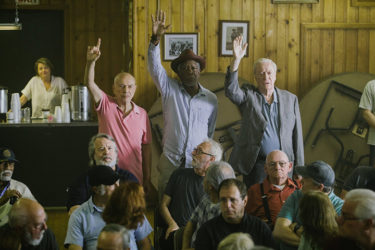Going in Style boasts the Oscar winning résumés of its stars Alan Arkin, Michael Caine and Morgan Freeman. Since its trailer dropped in December, it has portrayed itself as a sort of caper comedy—a Dirty Grandpa meets Ocean’s 11; Oceans 67, Geriatric Edition, if you will. The film itself is neither of these things and the most striking thing watching it is the internal struggle at work on screen.
Going in Style is a remake of the vaguely charming, mostly low-stakes 1979 comedy where Oscar winners Art Carney and George Burns and acting legend Lee Strasberg decide to rob a bank, mostly because of ennui. This 2017 remake, as a film of its time, immediately sets up the trio as losers in a corrupt system. And in typical fashion of a film seeking to tap into the zeitgeist, it rails against society’s disregard for the elderly, about the (presumably) inherently crooked nature of banks, and about the outsourcing of labour to the detriment of good red-blooded Americans. These are all elements of an incisive, if moralistic, film. The film’s least spontaneous moments come when Michael Caine, the mastermind of the trio, becomes a Bernie Sandersesque mouthpiece for all these issues, railing against the corrupt system. Inorganic, yes, but not necessarily problematic. There’s value in his spiel and the film discloses a distinct desire to consider. This becomes an issue when the film begins to struggle with its convergent desire to provide light, easily digestible entertainment.

Caine’s Joe is a pensioner who is at the bank to talk about the possibility of his house being foreclosed on because of his employer’s skipping out on pension payments. It is then that he becomes witness to a bank robbery. An incidental wrong-place-wrong-time incident becomes a right-place-right-time one when with one month left on his house and a discontinued pension scheme, Joe and his buddies decide to rob a bank. The screenplay coasts on the charm and gravitas of the actors themselves, never quite convincing us that these men would definitely decide on this tack to solve their issues. Sure, the set up might strain credulity but this sort of filmic hand waving isn’t the worst thing to happen and so the trio plot to rob the bank and the film covers their attempt to do so and the ensuing fall-out.
There’s a scene, mid-film, where the trio sit down before their planned heist and watch Sidney Lumet’s 1974 Dog Day Afternoon, which is arguably the best movie about a heist. We see Al Pacino’s frantic Sonny trying, and failing, to carry out a robbery. It should be a good intertextual moment but fails for two main reasons. The more obvious is that Going in Style is no Dog Day Afternoon and to invoke the spirit of that giant of a film leaves this one coming off as particularly effete. The incongruity deepens when you remember that Pacino, like Arkin, like Caine, and like Freeman (and DeNiro, and Hoffman and Hackman etc) are considered amongst the greatest actors of 1970s and 1980s Hollywood. Where are they now? Despite the film’s industry’s notably patriarchal power structure, these men aren’t necessarily doing stronger work or starring in better films than their similarly forgotten female counterparts. (Ann-Margaret as a mildly ditzy, romantic love-interest to Alan Arkin is hard to watch, even if she’s as game as anyone.) There’s no country for old men with serious films, we’re often reminded, and these actors are forced to go slumming it, hanging up their laurels for a quick pay-check. Going in Style is not quite an empty exercise for a pay-check but the divide between what is and what could be diminishes the enjoyment. Zach Braff is a serviceable director at best. He falls prey to some of the lazier directorial conceits that do not help the film – perfunctory split-screen for a telephone call, peppy montage to lift the spirits. But they don’t upend the film either. What remains pronounced is Going in Style as a movie at odds with itself. It wants, sometimes desperately, to deliver on the low stakes gut-busting but there’s a part of it that’s sadder, less easy to consume and darker. The end product is neither especially funny nor especially dramatic. It instead exists in a weird stasis, especially when Theodore Melfi’s screenplay is more routine than incisive, making the film feel like under-baked pie. It goes down easy enough but it sits heavy on the stomach. Niggling issues lie just beneath the surface. Like why does the single Latino in the film have to be a criminal? Or, how does the Americanism of the main plot stack up with its leading man Michael Caine playing to his natural British accent? The film loses something important by stacking the cards so heavily against its protagonists. Instead of offering a thoughtful look at how moments of desperation lead to crime, it seems afraid to make the trio anything less than saintly. So, there’s a critical kidney ailment, a grandfather stepping in for an absent father, and the aforementioned pension plot, robbing the actors of playing to any real nuance and setting the characters playing the establishment figures as immediately unappealing.
Am I taking this too seriously? Definitely. Still, the best comedies depend on their internal worlds being considered in earnest, not by treating their characters’ lives like easily solved jokes. But Going in Style is too easy. It flirts with the dangers of the real world and is happy to nod to and momentarily invoke the zeitgeist but it ultimately decides to err on the side of safety. Understandable, but still disappointing.
Have a comment? Write to Andrew at almasydk@gmail.com




